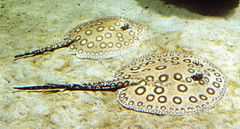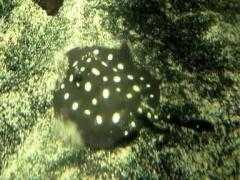Potamotrygonidae
| River stingrays | |
|---|---|
 | |
| Ocellate river stingray, Potamotrygon motoro | |
| Scientific classification | |
| Kingdom: | Animalia |
| Phylum: | Chordata |
| Class: | Chondrichthyes |
| Subclass: | Elasmobranchii |
| Order: | Myliobatiformes |
| Family: | Potamotrygonidae Garman, 1877 |
| Genera | |
|
Heliotrygon | |
River stingrays or freshwater stingrays are Neotropical freshwater fishes of the Potamotrygonidae family (order Myliobatiformes).
They are native to northern, central and eastern South America, living in rivers that drain into the Caribbean, and into the Atlantic as far south as the Río de la Plata in Argentina. Generally, each species is native to a single river basin, and the greatest species richness can be found in the Amazon.
River stingrays are almost circular in shape, and range in size from Potamotrygon schuhmacheri, which reaches 25 centimetres (9.8 in) in diameter, to the short-tailed river stingray, P. brachyura, which grows up to 1.5 metres (4.9 ft) in diameter. The upper surface is covered with denticles (sharp tooth-like scales). Most species are brownish or greyish and often have distinctive spotted or mottled patterns, but a few species are largely blackish with contrasting white spots.
They have a venomous caudal sting, and are one of the most feared freshwater fishes in the Neotropical region, sometimes more feared than piranhas and electric eels. However, they are not dangerous unless stepped on or otherwise threatened.
River stingrays are the only family of batoids completely restricted to fresh water habitats.[1][2] While there are true freshwater species in the family Dasyatidae, for example Himantura chaophraya, the majority of species in this family are saltwater fish.
Species

The taxonomy of the river stingrays is complex and undescribed species remain.
- Genus Heliotrygon Carvalho & Lovejoy, 2011
- Heliotrygon gomesi Carvalho & Lovejoy, 2011 (Gomes's round ray)[3]
- Heliotrygon rosai Carvalho & Lovejoy, 2011 (Rosa’s round ray)
- Genus Paratrygon A. H. A. Duméril, 1865
- Paratrygon aiereba Walbaum, 1792 (Discus ray)
- Genus Plesiotrygon Rosa, Castello & Thorson, 1987
- Plesiotrygon iwamae Rosa, Castello & Thorson, 1987 (Long-tailed river stingray)
- Plesiotrygon nana Carvalho & Ragno, 2011 (Black-tailed antenna ray)
- Genus Potamotrygon Garman, 1877
- Potamotrygon amandae Loboda & M. R. de Carvalho, 2013[4]
- Potamotrygon boesemani Rosa, M. R. de Carvalho & Almeida Wanderley, 2008 (Emperor ray) [5]
- Potamotrygon brachyura (Günther, 1880) (Short-tailed river stingray)
- Potamotrygon constellata (Vaillant, 1880) (Thorny river stingray)
- Potamotrygon falkneri Castex & Maciel, 1963 (Largespot river stingray)
- Potamotrygon henlei (Castelnau, 1855) (Bigtooth river stingray)
- Potamotrygon humerosa Garman, 1913
- Potamotrygon hystrix (J. P. Müller & Henle, 1834) (Porcupine river stingray)
- Potamotrygon leopoldi Castex & Castello, 1970 (White-blotched river stingray)
- Potamotrygon limai Fontenelle, J. P. C. B. da Silva & M. R. de Carvalho, 2014[6]
- Potamotrygon magdalenae (A. H. A. Duméril, 1865) (Magdalena river stingray)
- Potamotrygon marinae Deynat, 2006
- Potamotrygon motoro (J. P. Müller & Henle, 1841) (Ocellate river stingray)
- Potamotrygon ocellata (Engelhardt, 1912) (Red-blotched river stingray)
- Potamotrygon orbignyi (Castelnau, 1855) (Smoothback river stingray)
- Potamotrygon pantanensis Loboda & M. R. de Carvalho, 2013[4]
- Potamotrygon schroederi Fernández-Yépez, 1958 (Rosette river stingray)
- Potamotrygon schuhmacheri Castex, 1964 (Parana River stingray)
- Potamotrygon scobina Garman, 1913 (Raspy river stingray)
- Potamotrygon signata Garman, 1913 (Parnaiba River stingray)
- Potamotrygon tatianae J. P. C. B. da Silva & M. R. de Carvalho, 2011
- Potamotrygon tigrina M. R. de Carvalho, Sabaj Pérez & Lovejoy, 2011 (Tiger ray) [7]
- Potamotrygon yepezi Castex & Castello, 1970 (Maracaibo River stingray)
References
- ↑ Compagno, L. J. V. & S. F. Cook (1995) "The exploitation and conservation of freshwater elasmobranchs: status of taxa and prospects for the future". In: The Biology of Freshwater Elasmobranchs. Oetinger, M. I. & Zorzi, G. D. (eds.). Journal of Aquariculture & Aquatic Sciences, 7: 62–90.
- ↑ Freshwater Stingrays (Potamotrygonidae): status, conservation and management challenges CITES. AC20 Inf. 8.
- ↑ De Carvalho, M.R. and N.R. Lovejoy (2011). "Morphology and phylogenetic relationships of a remarkable new genus and two new species of Neotropical freshwater stingrays from the Amazon basin (Chondrichthyes: Potamotrygonidae)". Zootaxa (2776): 13–48.
- ↑ 4.0 4.1 Loboda, T.S.; de Carvalho, M.R. (2013). "Systematic revision of the Potamotrygon motoro (Müller & Henle, 1841) species complex in the Paraná-Paraguay basin, with description of two new ocellated species (Chondrichthyes: Myliobatiformes: Potamotrygonidae)" (PDF). Neotropical Ichthyology 11 (4): 693–737. doi:10.1590/s1679-62252013000400001.
- ↑ Rosa, de Carvalho & Wanderley (2008). "Potamotrygon boesemani (Chondrichthyes: Myliobatiformes: Potamotrygonidae), a new species of Neotropical freshwater stingray from Surinam". Neotropical Ichthyology 6 (1): 1–8. doi:10.1590/S1679-62252008000100001.
- ↑ Fontenelle, J.P., Da Silva, J.P.C.B. & De Carvalho, M.R. (2014): Potamotrygon limai, sp. nov., a new species of freshwater stingray from the upper Madeira River system, Amazon basin (Chondrichthyes: Potamotrygonidae). Zootaxa, 3765 (3): 249–268.
- ↑ de Carvalho, Perez & Lovejoy (2011). "Potamotyrgon tigrina, a new species of freshwater stingray from the upper Amazon basin, closely related to Potamotrygon schroederi Fernandez-Yepez, 1958 (Chondrichthyes: Potamotrygonidae)". Zootaxa 2827: 1–30.
- Froese, Rainer, and Daniel Pauly, eds. (2011). "Potamotrygonidae" in FishBase. February 2011 version.